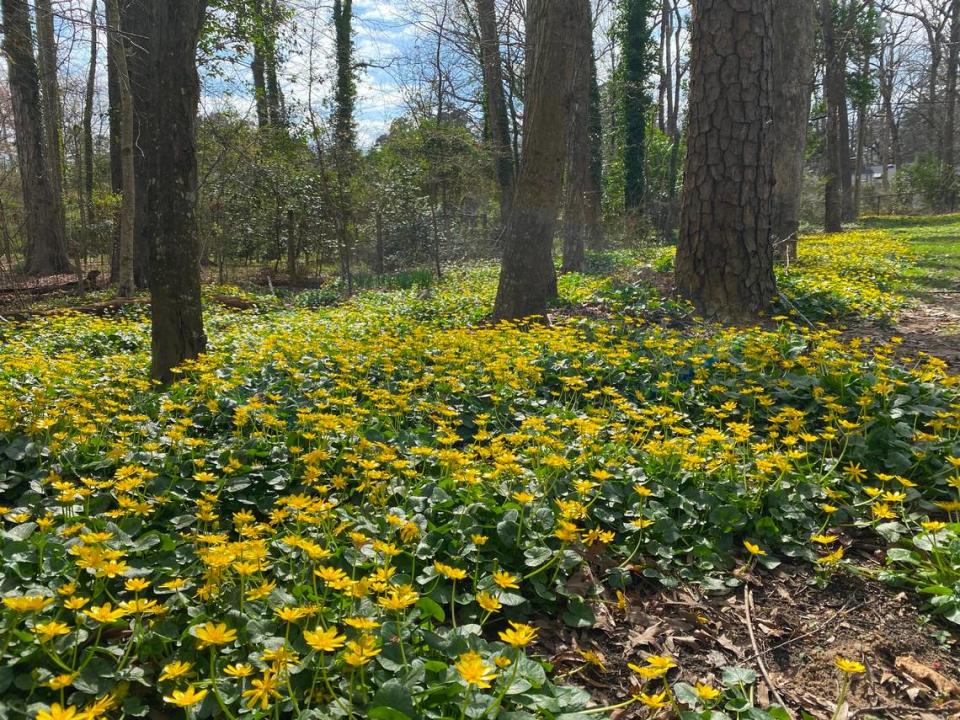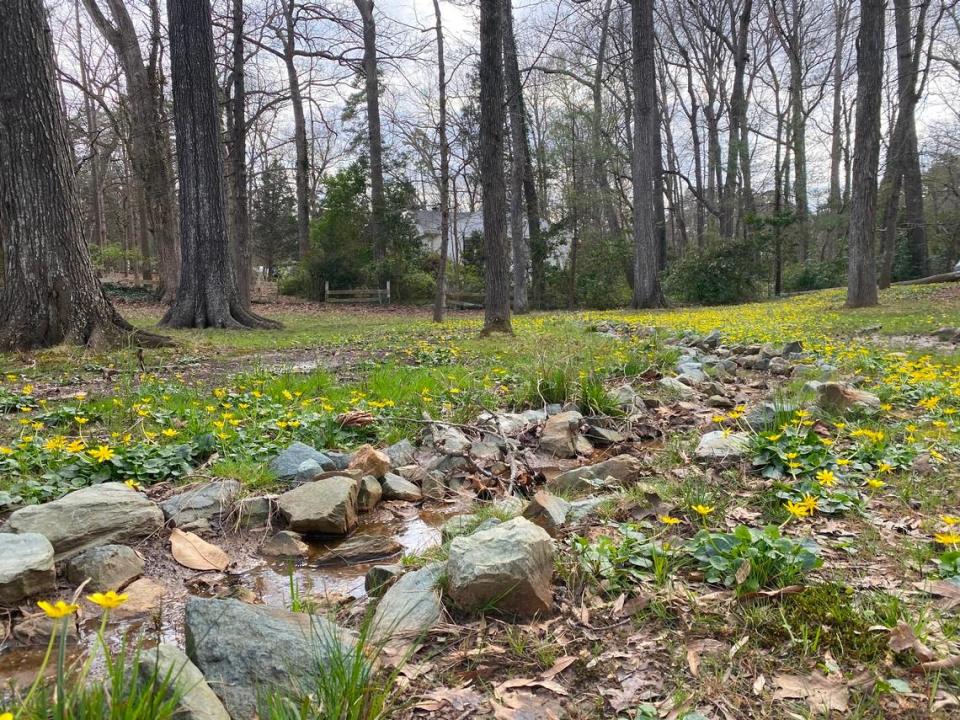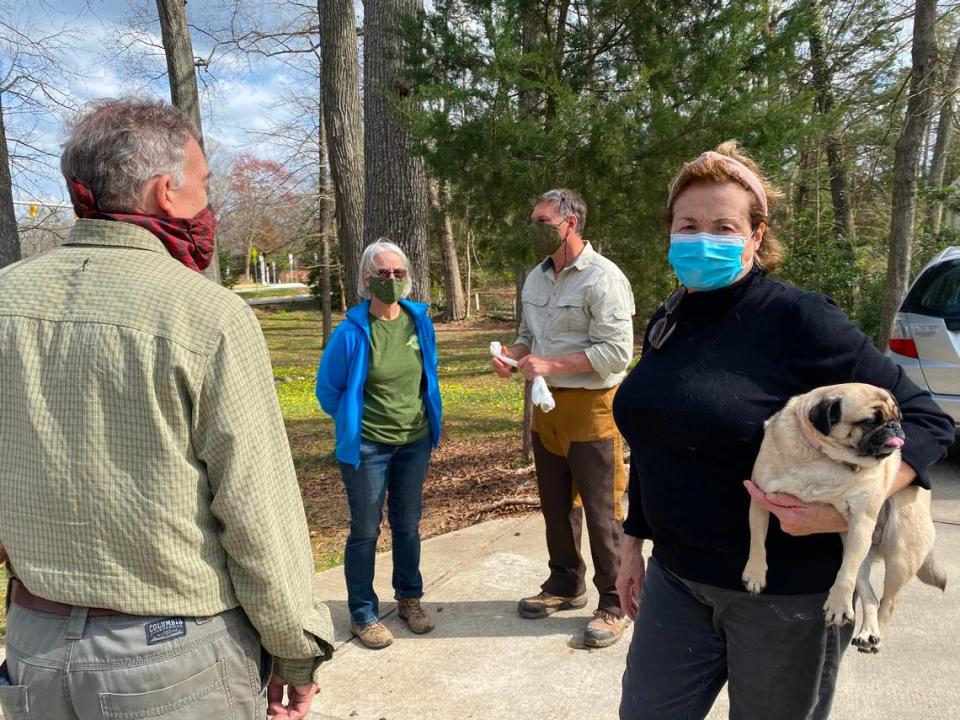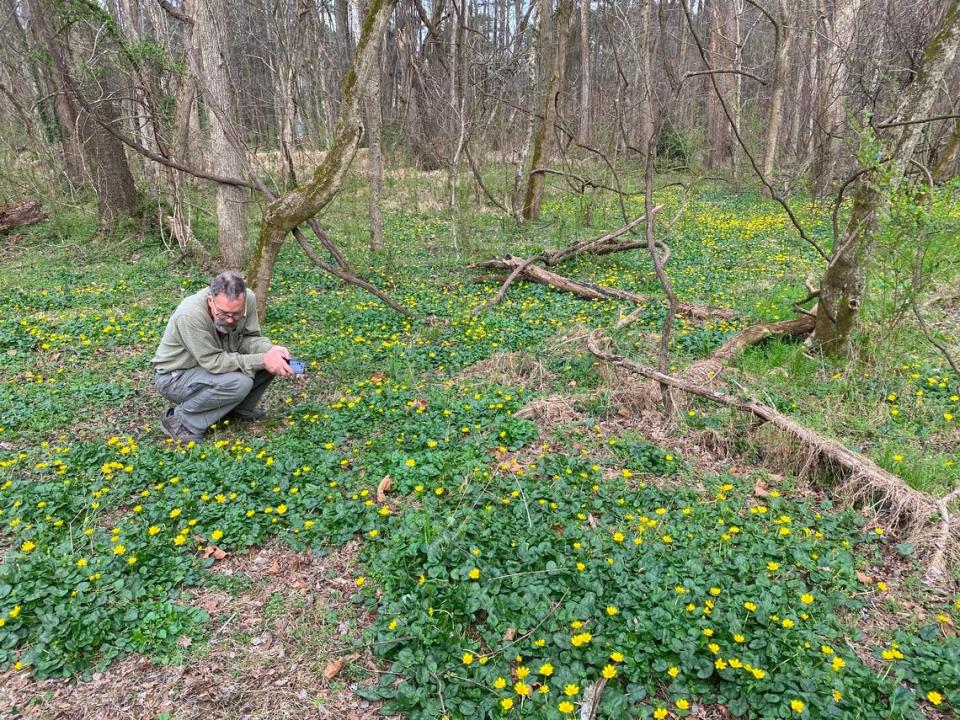This pretty yellow flower doesn’t belong in NC. And it’s harming Triangle backyards.
It floats downstream. After a spell of rain, water carries it through tributaries, where it nestles in the soil along rivers and creeks. For months, it lies unnoticed, hidden in the dirt.
But it reveals its presence when spring arrives. This year, it is taking over a watershed spanning Durham and Chapel Hill, popping up in parks and backyards like a rash on the earth’s surface.
Fig buttercup, or ficaria verna, is a bright yellow flower with glossy petals about the size of a nickel, surrounded by clumps of heart-shaped leaves the color of fresh spinach.
The spring perennial, also known as lesser celandine, has joined the ranks of other non-native plants that crowd out native species and ultimately harm the ecosystem, reducing biodiversity in the region.
English ivy, Bradford pear, Chinese privet, Japanese stilt grass and heavenly bamboo are other invasive plant species in the Triangle. Kudzu, native to East Asia, smothers trees like a net alongside roads across the South.
Leaders of the North Carolina Invasive Plant Council and the N.C. Botanical Garden say the spread of fig buttercup has grown at least 10 times larger in the last two years, and they are trying to stop it before they’re too late.
“If you don’t do anything about it, then you actually don’t have any chance to control it, and it’s out of control,” said Johnny Randall, director of conservation programs at the N.C. Botanical Garden. “But I think that, in this area, we are right on the cusp of being able to contain it or not.”
In mid-March, Randall joined colleagues Ann Prince and Pete Schubert to meet with a Chapel Hill homeowner on a plan to track down and stop fig buttercup’s growth.
Prince is a retired biologist and member of the Invasive Plant Council’s board of directors. Schubert, a former engineer, retired from the Environmental Protection Agency in 2015, and has sat on the council’s board for over eight years.
The three of them stood on Chuck and Valerie Hammer’s driveway. A shallow creek a foot wide cut through the Hammers’ yard, flowing from behind their home to an easement at the front of their property.
Fig buttercup blanketed patches of dirt near the creek and along the fence.

Invading local lawns
The three botanical experts met with the Hammers after Randall posted about fig buttercup on Nextdoor, a neighborhood social networking app.
The couple moved to Chapel Hill three years ago from the Washington, D.C., area. Chuck Hammer first noticed the flowers while mowing the lawn a few months after moving in.
“After the first torrential downpour, it was gone. Everything was washed away,” Hammer said. “But then I noticed this flat looking leaf and didn’t pay any attention to it.”
Standing over the flowering plants, Schubert told Hammer the lawnmower may have helped spread the plant.
“Inadvertently and unknowingly, you may have made it worse,” he said.
Fig buttercup crowds out native wildflowers, Schubert said. The dense clusters of leaves obscure the soil beneath the plant from sunlight, blocking anything beneath it from growing.
“If an acorn lands there and sprouts for its first year, it can’t out-compete this,” he said. “So you’re losing regeneration in the forest.”
The plant also disrupts the ecological system, he said. Native insects, including caterpillars, feast on native plants to survive. Birds eat the insects, and also carry seeds, supporting the growth of trees. “Native bees evolved with our native wildflowers,” he added. “Not this way.”

Multiplying by ‘many, many ways’
One way fig buttercup propagates is through bulbils, which develop on the plant’s stalk, Randall said.
The tiny bulbs grow where the leaf meets the stem and break off easily as the plant wears down by wind and rain. After they sit in the ground or travel through creeks during a flood, they grow into baby plants the following spring.
Another way the plant spreads is through tubers, which look like pale yellow marshmallows within the plant’s root structure. They also dislodge from the plant during a downpour and can colonize an area.
“This thing will multiply by many, many ways. That’s what makes it so insidious to get rid of,” Schubert said.
As a spring ephemeral, fig buttercups bloom once in March and April and wither away within a month. Most people who notice the flowers in their backyard or on their business property, may assume the plant is dead once it disappears by May.
But they would be wrong.
“It’s gone dormant. It’s underground,” Schubert said. “It’s still very much alive.”
Fig buttercup has likely been in the area for over a hundred years, intentionally or by accident, sold in nurseries and planted in garden beds, Randall said. But he thinks it started spreading two decades ago.
His theory is people may have discarded remnants of the plant as yard waste. When the vegetation turned into mulch at the landfill, it became compost for gardeners to use on their lawns.
Why has it grown so rapidly the last three years? They can only speculate, but Randall said 2019 was a year of heavy rain. Flood water may have carried the bulbils and tubers downstream from residential areas to New Hope Creek, which flows into Jordan Lake.
“If this goes untreated everywhere, unchecked, we will have this plant showing up on the periphery of all of those reservoirs,” Schubert said.

Herbicide and nature
Schubert, Randall and Prince suggested a solution for the Hammers: poison.
The couple could spray the fig buttercup’s foliage with a systemic herbicide engineered for broadleaf plants. The herbicide, made of 2% glyphosate, would break down in the soil after a few weeks, Schubert said, and kill the entire plant.
An herbicide approved for aquatic use would keep the chemical from harming the creek, Schubert said. Randall offered to send the Hammers a list of landscapers and price estimates.
Valerie Hammer, a gardener, wondered aloud whether the three plant experts would be successful.
“It’s filling in a vacuum. It’s the way nature works,” she said. “I’m sorry if it’s keeping out the other little guys that used to hang out here and were happy.”
“There are invasive plants, so they’re taken over, I understand that. But they have skills that make them extremely well-suited to survive. And that’s the way nature works,” she said. “It’s survival of the fittest. So what chance do you really have to eradicate all of this?”
The plant is spreading into residential neighborhoods from upstream, so it could return to their yard next year, Schubert said. But if the Invasive Plant Council can convince enough landowners to join their cause, they may prevent fig buttercup from becoming too established in the Triangle.
“You’re a candle in the wind,” the gardener told them.
“I know, you’re absolutely right,” Schubert said, calling himself “Don Quixote,” who gets “smacked off his horse” fighting windmills.
“But on the other hand,” he said. “I think we’ve got enough passionate people that know the science of invasive plants and see it with other species, that we’re not willing to give up yet.”
Hammer said she didn’t think of the fig buttercup as a problem.
“Personally, I think it’s pretty,” she said. “I think it’s better suited for this than anything else has been.”
Chuck Hammer said he would pay up to $200 to spray his lawn.
“I was hoping Chapel Hill ought to do it. They’re the stewards of our land and property,” he said. “I would think the town of Chapel Hill would have something in place where they would come in and take care of the citizens who live here and pay taxes.”

Bringing people into the cause
Ann Prince gazed at the patchwork of fig buttercup blanketing the ground beneath the trees.
Kneeling down in a squat, Randall stared at the flowers through his glasses, while Schubert stood off to the side, on the trail.
The three of them had gathered by the very spot, in Sandy Creek Park, where Prince first became aware of the plant’s threat two years ago.
“I came here to go birding with my husband. And I was like, ‘What’s this?’ Because, you know, it wasn’t a native plant,” Prince said. “And I thought, ‘this is a horrible patch.’”
In her hands, she gripped a map highlighting parts of the Sandy Creek Watershed where the plant has since taken root.
The three scientists want the N.C. Department of Agriculture and Consumer Services to classify fig buttercup as a noxious weed, which would bar nurseries from selling it and potentially lead to statewide regulation.
For now, the group relies largely on volunteers.
The Invasive Plant Council is applying for grants to fund professional herbicide sprayers to treat properties and parks where they have received permission. They’re partnering with Duke Forest, the N.C. Wildlife Resources Commission, and the US Army Corps of Engineers, in addition to Durham and Wake County parks departments.
Emma Rast, an intern for the botanical garden, cold-calls business owners and homeowner associations throughout the Sandy Creek Watershed to tell them about fig buttercup. They may agree to spray their property or to meet with someone from the botanical garden for an “inventory.”
Randall said he has been rebuffed by only one “really recalcitrant landowner,” who had been given a fig buttercup about 30 years ago as a gift. The friend who gave him the plant had mistaken it for a native flower, Marsh marigold.
Randall offered to spray the fig buttercup and give the landowner Marsh marigold instead, he said.
But the landowner refused.

